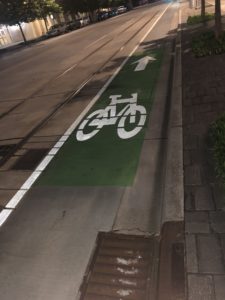I’m sitting in a car dealership, having recall work done. The perfect opportunity to start going through stuff on the computer and cleaning things out/reorganizing/deleting, etc. In digging through the files, I find an old post on bicycle safety from 2020 (wow! pre-COVID) that I apparently never put up. But it’s worth taking a look at it. I wrote it after going on a bike ride with local police officers. And my goodness, that day, they got to experience first-hand some of the craziness that people on bicycles experience ALL. THE. TIME. So I’ll just go ahead and put this out there.
You should think about this in light of all the new bike infrastructure now being built around town. Of course, it’s meant to make roads safer for all users. The whole “Complete Streets” philosophy entails making roads safer for ALL road users, rather than just getting motorists from Point A to Point B faster (which has been the operating principle of road design for quite some time). However, motorists are saying that bicyclists “taking over my streets” and “getting in the way of traffic” and “slowing me down” are just wrong. And they’re taking it out on anyone who disagrees with them…see the road rage incidents mentioned below against bicycling groups that include police officers!!!
Read on…
At the end of January, several LCIs/ride leaders met with officers from New Orleans Police Department’s First District for a bike ride. The inspiration for the ride came when Clark Thompson spoke with Captain LeJon Roberts at a neighborhood association meeting. To Capt. Robert’s statement , “We should go for a bike ride,” Clark responded, “OK. When?”
And so last week, Clark and I, and three other LCIs (Janneke van der Molen, John Strange, Scott Verdun) led a group including about a dozen officers (including Capt Roberts) on a bike ride through the CBD during evening rush hour. Blue Bikes provided bicycles to officers who needed them. The ride included a bit of the French Quarter, Baronne St, Loyola and Tulane Avenues, Galvez, Canal, and Broad Streets, and the Lafitte Greenway/Basin Street.
The officers were split into small groups, riding in plainclothes, so as not to attract any special attention. A mere three blocks from the start of the ride, one group experienced road rage as a motorist told us to quit blocking the street (in not so friendly terms). As soon as we crossed Canal, another group encountered a taxi driver blocking the bike lane, who, when approached and asked to move, threatened the ride leader (it didn’t hurt that Capt. Roberts was in that group).
On reaching Tulane and Loyola, because on the high volume of traffic, we elected not to move to the left lane to turn onto Tulane. Instead we did a two-stage turn, crossing Loyola and Tulane, then waiting for a green light to proceed on Tulane. The light turned green and a motorist gunned it to get in front of us and turn right, almost hitting an officer in the process.
We stopped along the way to discuss what we had seen, and to alert officers to upcoming challenges. We could not have planned for a better (worse?) outcome, as several incidents brought home the reality faced by bicycle drivers every day in the Big Easy…it’s not so easy for people on bicycles. The incidents I mentioned (and others along the way) brought a new level of awareness to the officers. We leaders could see/hear the “Aha!” moments on the ride.
At least this group of officers has a better understanding of how much different roads look when you’re under your own power on two wheels, rather than in a big metal box with the power of a gasoline engine. Capt. Roberts told us that he wants everyone in the First District to experience bicycle safety (or in this case bicycle “un-safety”), and that he will bring it up as something that should be done across the city.
And by the way, the next day, officers were in front of the business where the taxi driver was blocking the lane, handing out $300 tickets.
Small steps, big results. We’ll take it.
For more about These Guys’ efforts in law enforcement, see my post Bikes and the Law or Bicycling and Traffic Law 2018.



